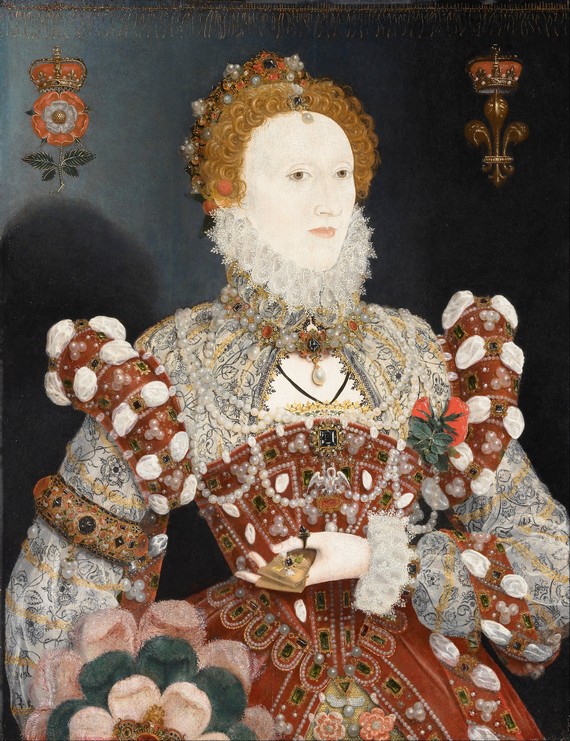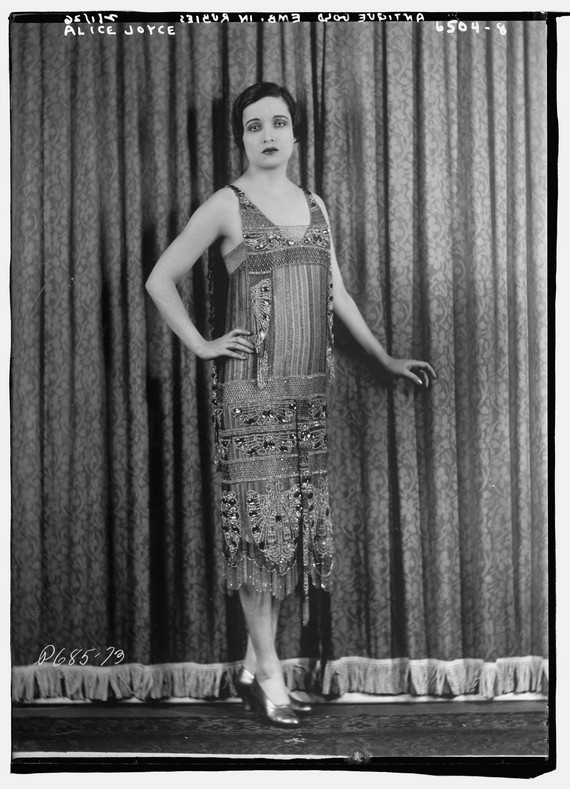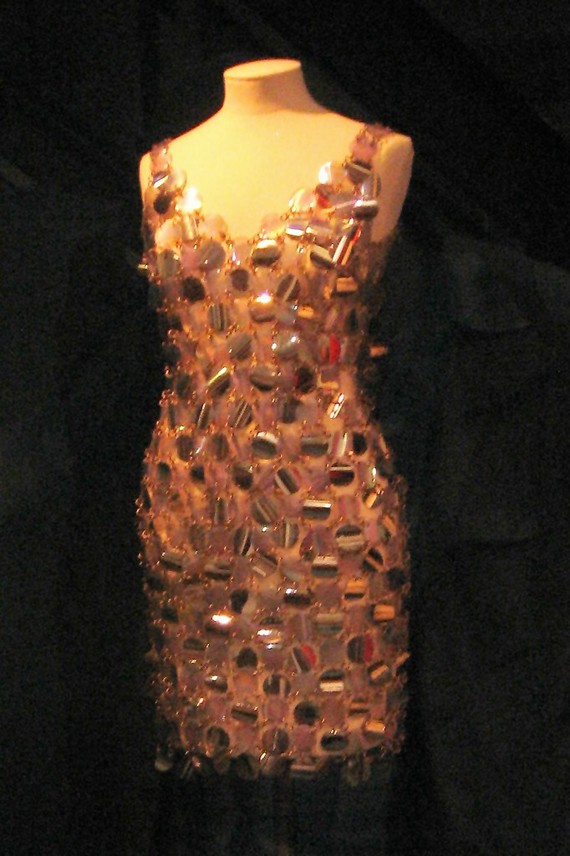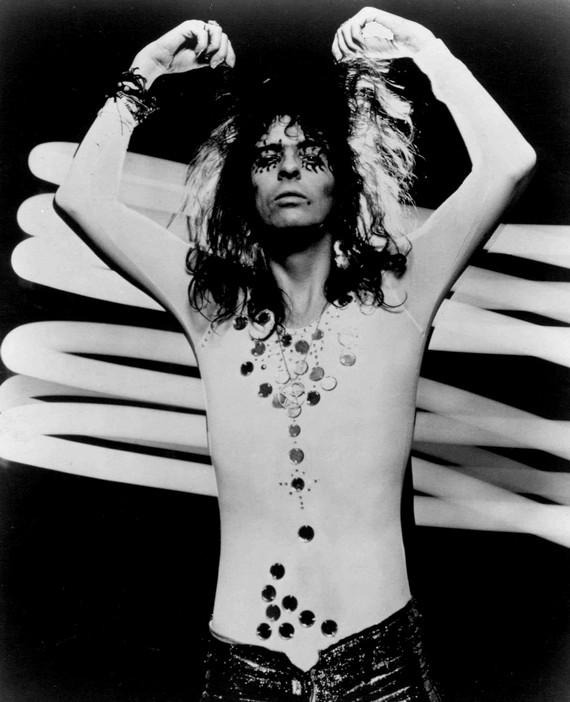The history of shiny, gold, glitter and sequins
December 31, 2017Because the shiny season is upon us, i.e. party time, it must be time to talk about the history of our attraction of wearing things that gleam, glitter, glisten or glow. Sequins, beads, lamé, encrustations of gold and glitter and gems – we have loved them for a very long time.
The original love of shiny came from a literal display of wealth. If you were wealthy you had gold and gems. And what’s the point of being rich if nobody knows about it? OK, you could invite people round and take them to the basement after tea to open a treasure chest or two and let them see. But that’s a lot of effort. Easier just to wear your wealth. That way, you don’t have to have the riff-raff round to yours all the time. I mean, obviously then the riff-raff might decide to kill you and nick it all, but presumably that’s a small price to pay for looking awesome.
So, the earliest use of gold and gems is not only in jewellery, but in clothes. It turns out the Ancient Egyptians were fashion leader in this respect, and have greatly influenced the Western world.
Clothes made of gold
Cloth of gold has been around for a very long time. It is made, literally, of gold, beaten so finely it forms a thread which can then be woven. It was often used in ecclesiastical garments, either as a full piece of cloth, or with the thread used in some fine embroideries. Gold and silver thread is also sometimes woven through fabric as a highlight, though when you see the clothes made with it today its hard to imagine the original effect as it tarnishes so much.
In medieval times, embroidery using silk threads and gold and silver was very famous around the world. It was called Opus Anglicanum (English Embroidery), because the English did it best. Most of the pieces were made for the nobility or for the church, because it was so time consuming and expensive.
Tudor Bling

Portrait of Queen Elizabeth I.
Walker Art Gallery, Public domain, via Wikimedia Commons
The Tudors, as famously exemplified by portraits of Queen Elizabeth I, loved to show their wealth through sewing gems onto their clothes. They would also stitch pieces of silver (or if not so rich, pewter would do) onto their garments as part of the design. I have also seen finger rings stitched into hair or onto their intricate, face framing collars. They were not subtle.
Gold – Victorian Sparkle
The Victorians were very keen on gold threads, embroidery and beading, especially for evening wear. Because homes were lit initially by candlelight, and then by gaslight, which also provided a soft, slightly flickering effect, these materials would have twinkled gently as the wearer moved.
Even when in mourning, Victorians liked their beading – many deep black dresses feature matching black beading, either in glass or in jet. Beading was a complicated and skilled technique, using tiny seed and bugle beads to create patterns of flowers, foliage and abstract patterns. Beading has been around since the ancient Mespotamian times, but it was the Ancient Egyptians who really refined it and made it their own. They invented Faiance beads, the turquoise beads you see decorating the Ancient Egyptian mummies.
1920s Sequins

Alice Joyce, 1926 in an Egyptian inspired, beaded dress.
Bain News Service, publisher, Public domain, via Wikimedia Commons
The burial garments of King Tutankhamun (1341 B.C.-1323 B.C.) have layers and layers of overlapping discs. I like to think of them as the first sequins. In a way they were – though not meant to make him look splendid under disco lights, they were definitely meant to give him a bit of bling for the afterlife – as well as cash, of course. When his tomb was discovered in 1922, his fashions were widely copied. People in the UK went crazy for Egyptomania in lots of different ways – fake hieroglyphs appeared on all sorts of items, models of Egyptian gods appeared, and beads and sequins were produced in the thousands, to be applied to evening dresses.
Initially, these sequins were made in metal – though not real gold – and they really weighed a dress down. They also tarnished really easily, quickly losing their allure. So attempts were made to find something else to make them from. An early solution was gelatine – yes, what we make jelly from. This was already used in film for photography. Sheets of this were lightweight, shiny, and could easily be coated with reflective substances and then punched into discs. However, like gelatine now, these discs also melted when wet or with heat. So, no going out in the rain or getting hot and sweaty. Eventually, Mylar, an early plastic was developed to do the same job.
1960s Sequins

A 1960s Paco Rabanne Dress.
The original uploader was Calliopejen at English Wikipedia., CC BY-SA 2.0 , via Wikimedia Commons
Sequins dropped out of fashion in the 1930s, but came back in the 1950s and by the 1960s, designers like Paco Rabanne were doing some outrageous things with them. He went back to metal and cut huge discs, applying them with pliers to chain mail dresses. He also used heavy discs of Perspex. Models who actually wore these designs reported them as being really uncomfortable, heavy and with sharp edges. But they looked incredibly striking.
1970s Glam

Alice Cooper in a sequinned bodysuit, 1972.
Associated Booking Corporation, Public domain, via Wikimedia Commons
By the 1970s, the era of glam, sequins were perhaps more popular than ever. As was glitter, and gold and silver lamé – anything that looked good at the disco. Glitter itself has a history about as old as sequins, as mica, a naturally sparkly rock, has been found ground into dust and added to cave paintings dating from the Upper Paleolithic period from 40,000 to 10,000 BCE. The Mayans used it too in their temples, and Cleopatra, the famous Egyptian queen, used glitter eye shadow made from the crushed wings of iridescent beetles.
The 70s had a flipside to their glam rock desires. This was the hippie movement, with a definite bent towards more natural and ecologically friendly clothes. But even the hippies liked sparkle. Not from plastic shiny things, but through their love of indigenous clothing and decorations from around the world. In the 1970s a decrease in cost of world travel along with the Beatle’s popularising India and its traditional religions, music and clothing meant that large amounts of the fabulous traditional mirror sewn clothes made in Rajasthan was imported to the UK, and worn alongside home made clothes and second hand finds.
Gold – 1980s and 1990s Gems
The 80s were the decade of big, bold fashion choices, both in clothes and jewellery. Big shoulder pads were in for women along with bright colours, and costume jewellery came in large dimensions and unlikely bright hues. This was clearly how the be-gemmed jumpers were born. Many examples have broad shoulders and a pattern of large, fake jewels sewn around the neckline or yoke.
The 90s was supposed to be a subtler time for fashion, and crushed velvet was probably the shiniest thing that was worn. It’s only recently really that truly over the top glitter and shine has been worn with abandon once more. And long may it last!


